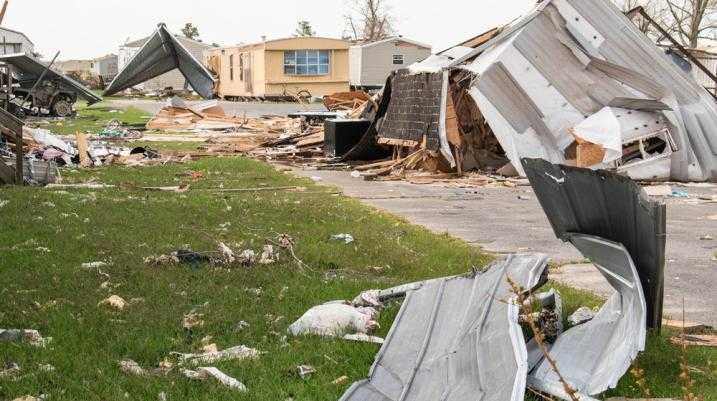What Were the Worst Hurricanes in U.S. History?

Every hurricane season, live coverage provided by the Weather Channel, featuring brave reporters like Jim Cantore and Mike Seidel, gives us a firsthand look at the devastation caused by these powerful storms. From the Gulf of Mexico to the Cape Verde Islands off the coast of West Africa, hurricanes can wreak havoc from Martha’s Vineyard to Brownsville, Texas. The United States has seen its fair share of destructive hurricanes throughout history.
Here, we’ve compiled a list of the worst hurricanes to make landfall in the U.S. What makes a hurricane the "worst" is a combination of the loss of life and the value of property damage. Let’s take a look at some of the most devastating hurricanes in U.S. history.
#12: Hurricane Charley (2004)
Hurricane Charley epitomizes unpredictability in hurricane forecasting. Initially predicted to hit the Tampa Bay-St. Petersburg area, Charley made a sudden turn and tore through Punta Gorda and Port Charlotte, then sped inland with 80 mph winds reaching Orlando. Charley left behind more than $20 billion in property damage.
#11: The 1938 Hurricane
New England bore the brunt of the 1938 hurricane, with wind speeds exceeding 180 mph destroying more than 150 houses in Westhampton, New York. A 14-foot storm surge engulfed Long Island's south coast, killing hundreds and marking it as New England’s deadliest and costliest hurricane.
#10: Superstorm Sandy (2012)
Superstorm Sandy impacted 24 states, making it the second costliest tropical storm in U.S. history with over $50 billion in damages. Nearly nine million residents lost power. Sandy's vast swath even helped fuel a winter storm in the Great Lakes region.
#9: Hurricane Irma (2017)
Hurricane Irma remained intact for almost two weeks, causing significant damage in the Caribbean before hitting the Florida Keys and South Florida with 180 mph winds. Irma caused $65 billion in property damage, making it the second-costliest Caribbean hurricane.
#8: Hurricane Michael (2018)
As the first Category 5 hurricane to hit the U.S. in nearly 30 years, Michael made landfall near Mexico Beach, Florida, with winds over 160 mph. Sixteen people died, and the storm caused over $25 billion in property damage.
#7: Hurricane Camille (1969)
Hurricane Camille's power destroyed all wind-measuring instruments in Galveston Bay. Camille came ashore with a 24-foot storm surge, killing 259 people and causing $1.4 billion in property damage.
#6: Hurricane Andrew (1992)
Projected to devastate Miami, Andrew instead hit Homestead and Elliott Key. The Category 3 storm destroyed nearly 130,000 homes with 160 mph winds and caused significant damage in Louisiana after moving into the Gulf of Mexico.
#5: The 1926 Hurricane
This hurricane’s tragedy was compounded by the lack of modern weather detection. A 10-foot storm surge from Lake Okeechobee killed around 2,500 people in Miami. Property damage translated to over $1 trillion in today’s currency.
#4: Hurricane Harvey (2017)
Hurricane Harvey displaced more than 30,000 residents in the Houston area. Heavy rain overwhelmed sewers and destroyed bridges. Harvey’s $125 billion in property damage matched Katrina’s.
#3: 1900 Hurricane
Over 8,000 lives were lost along Galveston’s coast due to a 20-foot storm surge and 120 mph winds. Lack of weather detection equipment left residents and tourists unprepared for the hurricane’s arrival.
#2: Hurricane Katrina (2005)
Katrina’s 25-foot storm surge in Mississippi contributed to over 1,800 deaths. A compromised levee system caused deadly flooding in 80 percent of New Orleans. Property damage exceeded $100 billion.
#1: Hurricane Maria (2017)
With sustained winds over 175 mph, Hurricane Maria devastated Puerto Rico, claiming more than 3,000 lives and causing nearly $100 billion in property damage. Maria remains the deadliest Atlantic hurricane in recorded history.
What are the Dangers of a Hurricane?
While breathtaking from space, hurricanes pose incredible dangers. Five weather factors pose the greatest threats:
- Storm Surge: The primary cause of structural damage and loss of life, storm surge can exceed 20 feet and travel miles inland.
- Inland Flooding: Slow-moving hurricanes produce torrential rains leading to severe flooding, as seen with Hurricane Harvey.
- High Winds: Wind speeds defined by the Saffir-Simpson Hurricane Wind Scale can destroy buildings and create deadly projectiles.
- Rip Currents: Hurricanes can create dangerous rip currents even if they don’t make landfall, posing threats to coastal cities.
- Tornadoes: Around 20 percent of U.S. tornadoes result from hurricanes, often hidden by rain and difficult to detect from the ground.
Understanding these dangers is crucial for preparedness and safety during hurricane season.
Injured? Getting the compensation you deserve starts here.

Injured?
Not sure what to do next?
We'll guide you through everything you need to know.